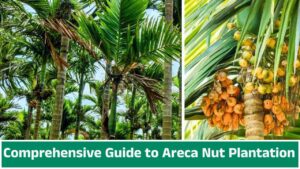Comprehensive Guide to Areca Nut Plantation
Areca nut, also known as betel nut, is a significant commercial crop grown in many tropical and subtropical regions. Its cultivation is crucial for the livelihoods of millions of farmers across countries like India, Indonesia, Myanmar, and Sri Lanka. This guide delves into the various aspects of areca nut plantation, including its history, cultivation practices, economic importance, challenges, and environmental impact.

1. Introduction to Areca Nut
The areca nut is the seed of the Areca catechu palm, commonly used as a stimulant in combination with betel leaves. It is a vital crop in Southeast Asia and the Indian subcontinent due to its cultural and medicinal significance.
- Scientific Name: Areca catechu
- Common Names: Betel nut, Supari (India), Pinang (Malaysia).
- Uses: Chewing with betel leaves, medicinal products, and cultural rituals.
2. History and Cultural Significance
The cultivation of areca nut dates back thousands of years, particularly in South and Southeast Asia.
- Historical Roots:
- Archaeological evidence suggests the use of areca nut in India over 2,000 years ago.
- It has been mentioned in ancient Sanskrit texts and Ayurvedic scriptures.
- Cultural Role:
- Used in religious ceremonies and social gatherings.
- Symbolizes hospitality and goodwill in many cultures.
3. Ideal Conditions for Areca Nut Cultivation
- Climate:
- Requires a tropical climate with high humidity.
- Temperature: 14–36°C (optimal range: 20–30°C).
- Rainfall: 1,500–3,000 mm annually.
- Soil:
- Prefers well-drained, fertile soil with good organic content.
- Soil pH: 5.5–6.5 is ideal.
- Topography:
- Grows well in plains and sloping terrains up to 1,000 meters above sea level.
4. Propagation and Planting
- Propagation:
- Areca nut is propagated through seeds.
- Seeds are selected from healthy, high-yielding palms.
- Planting:
- Spacing: 2.7m x 2.7m for traditional varieties.
- Pits: Dug to 60x60x60 cm dimensions, filled with organic manure.
- Best Time: Monsoon season ensures good root establishment.
5. Varieties of Areca Nut
- Traditional Varieties:
- Mangala, Mohitnagar, Sumangala, Thirthahalli.
- Hybrid Varieties:
- Developed for higher yield and disease resistance.
6. Crop Management Practices
- Irrigation:
- Regular watering during dry periods is essential.
- Drip irrigation is efficient for areca nut plantations.
- Manuring and Fertilization:
- Organic manure like compost or green manure is beneficial.
- Fertilizer Schedule (per palm/year):
- Urea: 100–150g.
- Superphosphate: 150–200g.
- Potash: 200–250g.
- Weed Control:
- Manual weeding is common.
- Mulching helps retain soil moisture and suppress weeds.
- Pest and Disease Management:
- Major Pests: Arecanut caterpillar, white grubs.
- Common Diseases: Yellow leaf disease, root rot.
- Control Measures: Use of biopesticides, maintaining field hygiene.
7. Harvesting and Processing
- Harvesting:
- Begins 5–7 years after planting.
- Harvesting is done manually using climbing tools.
- Processing:
- Fresh nuts are boiled, dehusked, and sun-dried for preservation.
- Two types of products:
- Chali (dried nuts).
- Kalipak (boiled and dried nuts).
8. Economic Importance
- Employment Generation:
- Provides livelihoods for millions in rural areas.
- Labor-intensive during planting, harvesting, and processing.
- Export Revenue:
- India is one of the largest exporters of areca nut.
- Major importers include the Middle East and Southeast Asia.
- Byproducts:
- Areca nut husk is used in making coir, handicrafts, and biofuel.
9. Challenges in Areca Nut Cultivation
- Pests and Diseases:
- Yellow leaf disease is a major threat.
- Regular monitoring and preventive measures are necessary.
- Price Fluctuations:
- Global market trends significantly impact areca nut prices.
- Health Concerns:
- Excessive consumption of areca nut has been linked to health issues, including oral cancer.
- Environmental Concerns:
- Unsustainable practices can lead to soil degradation.
10. Government Support and Policies
- Subsidies:
- Governments provide financial assistance for fertilizers and irrigation systems.
- Research and Development:
- Institutes like CPCRI (Central Plantation Crops Research Institute) work on improving yield and disease resistance.
- Market Assistance:
- Farmer cooperatives and government agencies ensure fair pricing.
11. Sustainability and Future Prospects
- Sustainable Practices:
- Organic farming methods and crop diversification.
- Water conservation through drip irrigation.
- Future Trends:
- Increased mechanization to reduce labor costs.
- Development of value-added products like areca nut powder and extracts.
12. Areca Nut in Global Markets
- Major Producers:
- India, Indonesia, Myanmar, Bangladesh.
- Major Consumers:
- India, Thailand, China, and several Gulf countries.
- Export Products:
- Raw areca nut, processed betel nut, and husk-derived products.
13. Health Benefits and Risks
- Potential Benefits:
- Traditional medicine claims benefits for digestion and oral health.
- Health Risks:
- Chewing areca nut is addictive and linked to severe health issues like oral cancer and gum disease.
14. Conclusion
Areca nut cultivation plays a crucial role in rural economies and global markets. Despite its challenges, sustainable practices, government support, and technological advancements are paving the way for a prosperous future for areca nut farming.
This comprehensive guide captures the essence of areca nut plantation, highlighting its importance, cultivation techniques, and the need for sustainable development in this sector.
